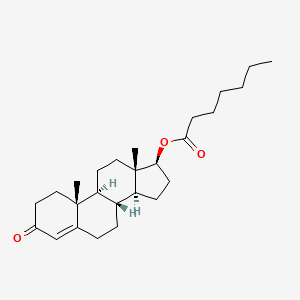Testosterone Enanthate Information
Click here to view all Testosterone Enanthate productsThe information, including but not limited to, text, graphics, images and other material contained on this website are for informational purposes only. No material on this site is intended to be a substitute for the consultation, diagnosis, and/or medical treatment of a qualified physician or healthcare provider.


What is Testosterone Enanthate?
Testosterone Enanthate is an anabolic androgenic steroid (AAS) that is commonly used in medical and non-medical settings. It is a synthetic derivative of testosterone, the primary male sex hormone, and is used to supplement or replace natural testosterone in the body. Here are some details about Testosterone Enanthate:
- Medical Uses: Testosterone Enanthate is prescribed by healthcare professionals for various medical conditions, including hypogonadism (low testosterone levels), delayed puberty in males, and certain breast cancers in women. It helps to restore testosterone levels and promote the development of secondary sexual characteristics.
- Hormonal Effects: Testosterone Enanthate is a long-acting testosterone ester, which means it is slowly released into the bloodstream after injection. Once absorbed, it binds to androgen receptors in various tissues, affecting gene expression and promoting anabolic (muscle-building) and androgenic (masculinizing) effects.
- Dosage and Administration: The dosage of Testosterone Enanthate can vary depending on the specific medical condition and individual needs. In medical settings, injections are typically administered every 1 to 4 weeks, with doses ranging from 50 to 400 mg per injection. Non-medical use may involve higher doses, but it is important to note that non-prescribed use of anabolic steroids is illegal in many countries.
- Side Effects: Like any medication or steroid, Testosterone Enanthate can have potential side effects. These can include acne, oily skin, fluid retention, increased blood pressure, changes in cholesterol levels, mood swings, decreased sperm production, testicular atrophy (shrinkage of the testicles), and increased risk of cardiovascular problems.
- Precautions and Contraindications: Testosterone Enanthate should not be used by individuals with prostate or breast cancer, pregnant or breastfeeding women, or those who have a known hypersensitivity to the drug. It is important to discuss your medical history and any medications you are taking with a healthcare professional before starting Testosterone Enanthate.
- Legal Status: The use of Testosterone Enanthate without a prescription or for non-medical purposes is considered illegal in many countries. It is classified as a controlled substance in the United States and is regulated by various drug control laws.
Please note that the information provided here is for informational purposes only and should not be considered as medical advice. It is important to consult with a qualified healthcare professional for personalized guidance and information about the specific uses and risks associated with Testosterone Enanthate.
How Testosterone Enanthate works?
Testosterone Enanthate works by supplementing or replacing the natural testosterone in the body. Here's a breakdown of how it works:
- Administration: Testosterone Enanthate is typically administered via intramuscular injection. Once injected into the muscle, it forms a depot or reservoir from which testosterone is slowly released into the bloodstream over time.
- Testosterone Release: Testosterone Enanthate is an esterified form of testosterone. The ester (in this case, Enanthate) is attached to the testosterone molecule, which allows for a slower and more sustained release of testosterone into the bloodstream compared to natural testosterone.
- Binding to Androgen Receptors: Once in the bloodstream, the released testosterone binds to androgen receptors in various tissues throughout the body. Androgen receptors are found in the cytoplasm of target cells, and when testosterone binds to them, it forms a testosterone-receptor complex.
- Translocation to the Nucleus: The testosterone-receptor complex moves into the cell nucleus, where it binds to specific DNA sequences called hormone response elements (HREs). This binding triggers a series of molecular events that modulate gene expression.
- Gene Expression: The testosterone-receptor complex bound to HREs initiates the transcription of specific genes. These genes are involved in various physiological processes, including protein synthesis, nitrogen retention, muscle growth, bone density regulation, red blood cell production, and the development of secondary sexual characteristics.
- Anabolic and Androgenic Effects: The anabolic effects of Testosterone Enanthate are related to its ability to promote protein synthesis and nitrogen retention, leading to increased muscle mass, strength, and recovery. The androgenic effects refer to the masculinizing effects, such as the growth of facial and body hair, deepening of the voice, and increased libido.
It's important to note that the effects of Testosterone Enanthate extend beyond the desired anabolic effects and can include potential side effects. The specific effects experienced can vary based on factors such as dosage, individual response, and overall health.
Synonyms of Testosterone Enanthate
- testosterone enanthate
- 315-37-7
- Delatestryl
- Testosterone heptanoate
- Androtardyl
- Testosterone enantate
- Testosterone heptylate
- Atlatest
- Testanthate
- Testinon
- Testoenant
- Testostroval
- Everone
- Orquisteron-E
- Exten test
- Depo-Testro Med
- Testosterone oenanthate
- Andropository
- Durathate
- Testenate
- Testosterone heptoate
- Reposo-TMD
- Primotestone
- Malogen L.A.
- DePatestrye
- Testosterone 17-enanthate
- NSC-17591
- Malogen L.A.200
- Reposo TMD
- Testonenant
- Ditate
- Andro L.A. 200
- 17-Hydroxyandrost-4-en-3-one, 17-heptanoate
- Delatest
- Testate
- Xyosted
- Testosterone, heptanoate
- Heptanoic acid, ester with testosterone
- 17-((1-Oxoheptyl)oxy)androst-4-en-3-one
- 17beta-Enanthoxyandrost-4-en-3-one
- 4-Androsten-3-one 17beta-enanthate
- Androgyn L.A.
- Androst-4-en-3-one, 17-[(1-oxoheptyl)oxy]-, (17b)-
- Testosterone ethanate
- CCRIS 7082
- DEA No. 4000
- 17beta-Hydroxyandrost-4-en-3-one enanthate
- EINECS 206-253-5
- Androst-4-en-3-one, 17-((1-oxoheptyl)oxy)-, (17beta)-
- Testosterone enanthate ciii
- BRN 3170544
- CHEBI:9464
- UNII-7Z6522T8N9
- Testosterone enanthate [USP:JAN]
- Testosterone enanthate [USAN:JAN]
- Androst-4-en-3-one, 17beta-hydroxy-, heptanoate
- C26H40O3
- 7Z6522T8N9
- [(8R,9S,10R,13S,14S,17S)-10,13-dimethyl-3-oxo-1,2,6,7,8,9,11,12,14,15,16,17-dodecahydrocyclopenta[a]phenanthren-17-yl] heptanoate
- Androst-4-en-3-one, 17-(1-oxoheptyl)oxy-, (17beta)-
- 17-heptanoyl-17beta-hydroxyandrost-4-en-3-one
- 4-08-00-00979 (Beilstein Handbook Reference)
- Theramex
- Androst-4-en-3-one, 17-[(1-oxoheptyl)oxy]-, (17.beta.)-
- (8R,9S,10R,13S,14S,17S)-10,13-Dimethyl-3-oxo-2,3,6,7,8,9,10,11,12,13,14,15,16,17-tetradecahydro-1H-cyclopenta[a]phenanthren-17-yl heptanoate
- 17-[(1-Oxoheptyl)oxy]androst-4-en-3-one
- Androgyn L.A
- Malogen L.A
- Delatestryl (TN)
- Testosteroni enantas
- Ditate (Salt/Mix)
- Deladumone (Salt/Mix)
- Testosterone heptoic acid
- Enanthic acid testosterone
- SCHEMBL42687
- Androgyn L.A. (Salt/Mix)
- Testosterone 17beta-heptanoate
- CHEMBL1200335
- Androst-4-en-3-one, heptanoate
- DTXSID701016540
- Testosterone 17beta-heptanoic acid
- TESTOSTERONE ENANTHATE [MI]
- DRG-0260
- NSC17591
- Testosterone enanthate (JP17/USP)
- TESTOSTERONE ENANTHATE [JAN]
- LMST02020075
- s3717
- Androst-4-en-3-one,(17.beta.)-
- TESTOSTERONE ENANTATE [MART.]
- TESTOSTERONE ENANTHATE [VANDF]
- AKOS015960945
- TESTOSTERONE ENANTATE [WHO-IP]
- CCG-268655
- CS-O-05333
- DB13944
- TESTOSTERONE ENANTHATE [USP-RS]
- TESTOSTERONE ENANTHATE [WHO-DD]
- 4-Androsten-3-one 17.beta.-enanthate
- 3-oxoandrost-4-en-17beta-yl heptanoate
- AC-12599
- DS-11585
- Testosterone enanthate, analytical standard
- 4-Androsten-17beta-ol-3-one 17-enanthate
- LS-148818
- TESTOSTERONE ENANTATE [EP MONOGRAPH]
- TESTOSTERONE ENANTHATE [ORANGE BOOK]
- TESTOSTERONI ENANTAS [WHO-IP LATIN]
- 17beta-hydroxyandrost-4-en-3-one heptanoate
- TESTOSTERONE ENANTHATE CIII [USP-RS]
- TESTOSTERONE ENANTHATE [USP MONOGRAPH]
- WLN: L E5 B666 OV MUTJ A E FOV6
- C08157
- D00958
- DITATE-DS COMPONENT TESTOSTERONE ENANTHATE
- 17-Hydroxyandrost-4-en-3-one, 17-heptanoic acid
- SR-01000942262
- SR-01000942262-1
- TESTOSTERONE ENANTHATE COMPONENT OF DITATE-DS
- W-106891
- Androst-4-en-3-one, 17.beta.-hydroxy-, heptanoate
- Q27108402
- 3-Oxoandrost-4-en-17-yl heptanoate, (17.beta.)- #
- 17.BETA.-(HEPTANOYLOXY)ANDROST-4-EN-3-ONE [WHO-IP]
- Androst-4-en-3-ona, 17-[(1-oxoheptil)oxi]-, (17beta )-
- ANDROST-4-EN-3-ONE, 17-(1-OXOHEPTYL)OXY-, (17.BETA.)-
- Testosterone enantate, European Pharmacopoeia (EP) Reference Standard
- Testosterone enanthate, United States Pharmacopeia (USP) Reference Standard
- Testosterone enantate for peak identification, European Pharmacopoeia (EP) Reference Standard
- Testosterone enantate for system suitability, European Pharmacopoeia (EP) Reference Standard

